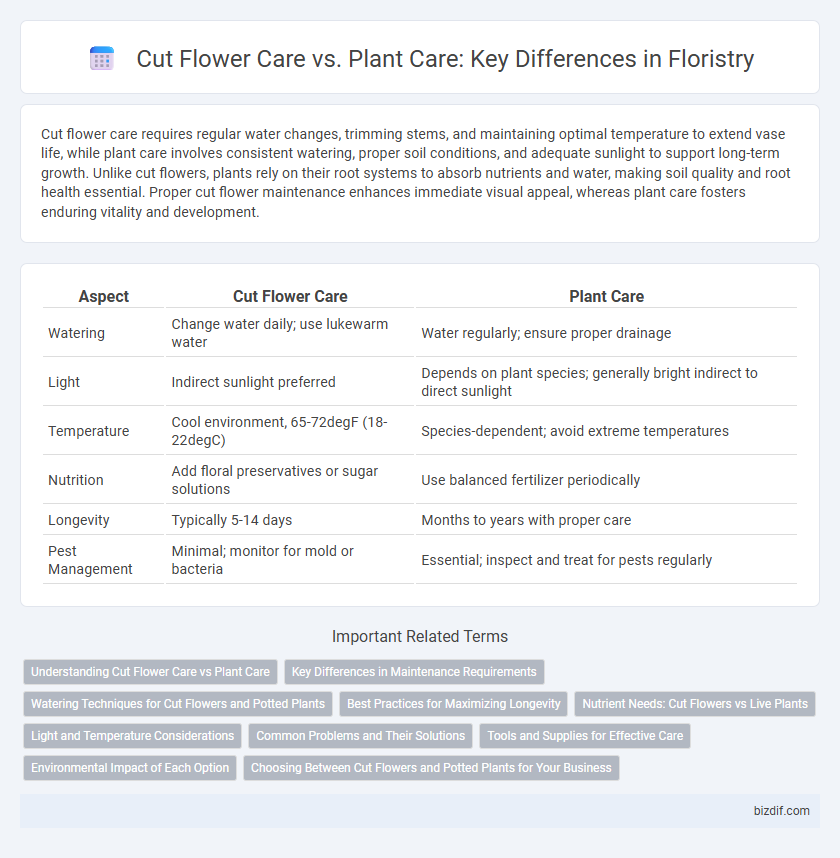Cut flower care requires regular water changes, trimming stems, and maintaining optimal temperature to extend vase life, while plant care involves consistent watering, proper soil conditions, and adequate sunlight to support long-term growth. Unlike cut flowers, plants rely on their root systems to absorb nutrients and water, making soil quality and root health essential. Proper cut flower maintenance enhances immediate visual appeal, whereas plant care fosters enduring vitality and development.
Table of Comparison
| Aspect | Cut Flower Care | Plant Care |
|---|---|---|
| Watering | Change water daily; use lukewarm water | Water regularly; ensure proper drainage |
| Light | Indirect sunlight preferred | Depends on plant species; generally bright indirect to direct sunlight |
| Temperature | Cool environment, 65-72degF (18-22degC) | Species-dependent; avoid extreme temperatures |
| Nutrition | Add floral preservatives or sugar solutions | Use balanced fertilizer periodically |
| Longevity | Typically 5-14 days | Months to years with proper care |
| Pest Management | Minimal; monitor for mold or bacteria | Essential; inspect and treat for pests regularly |
Understanding Cut Flower Care vs Plant Care
Cut flower care prioritizes water quality, stem trimming, and timely replacement of vase water to prolong bloom life, while plant care emphasizes soil health, root maintenance, and consistent light exposure to ensure overall growth. Proper hydration and nutrient delivery are critical for cut flowers since they no longer have access to soil, unlike plants that absorb moisture and minerals through their root systems. Understanding these distinctions helps florists and gardeners apply targeted techniques to maintain flower freshness and plant vitality effectively.
Key Differences in Maintenance Requirements
Cut flower care requires frequent water changes and stem trimming to prolong vase life, while plant care involves regular watering, soil monitoring, and nutrient feeding to support ongoing growth. Cut flowers demand immediate attention to prevent bacterial growth, whereas plants benefit from consistent environmental conditions and root health maintenance. These distinct maintenance routines reflect the temporal nature of cut flowers versus the long-term care strategy essential for living plants.
Watering Techniques for Cut Flowers and Potted Plants
Watering techniques for cut flowers emphasize frequent hydration with clean, lukewarm water to maintain stem turgidity and prolong vase life, often supplemented with floral preservatives. In contrast, potted plants require balanced watering schedules tailored to their species, ensuring soil moisture without waterlogging to support root health and prevent fungal diseases. Proper water quality, temperature, and absorption rates are critical factors influencing the vitality of both cut flowers and potted plants.
Best Practices for Maximizing Longevity
Cut flower care involves regular water changes, use of floral preservatives, and trimming stems at an angle to enhance water absorption, which maximizes vase life and freshness. Plant care emphasizes proper watering, adequate sunlight, nutrient-rich soil, and pruning to promote healthy growth and longevity in living plants. Both practices benefit from maintaining optimal environmental conditions and minimizing stress to extend the lifespan of flowers and plants.
Nutrient Needs: Cut Flowers vs Live Plants
Cut flowers require specialized floral preservatives containing sugars, biocides, and acidifiers to maintain hydration and extend vase life by supplying essential nutrients externally. Live plants absorb nutrients through their root systems from soil, relying on macronutrients like nitrogen, phosphorus, and potassium to support growth and photosynthesis. While cut flowers depend on water-based nutrient solutions for limited longevity, live plants require ongoing soil nutrient replenishment for sustained health and development.
Light and Temperature Considerations
Cut flowers require moderate indirect light and cooler temperatures around 65-72degF to prolong freshness and prevent wilting. In contrast, plants thrive with specific light intensities, often needing bright, indirect sunlight and stable temperatures between 70-85degF for optimal growth. Maintaining appropriate light and temperature conditions tailored to cut flowers versus living plants is crucial for their longevity and health.
Common Problems and Their Solutions
Cut flower care requires frequent water changes and precise stem trimming to prevent bacterial growth and wilting, while plant care focuses on proper soil moisture and nutrient balance to avoid root rot and nutrient deficiencies. Common problems in cut flowers include drooping and browning petals caused by dehydration or microbial infection, solved by using floral preservatives and maintaining clean water. In plants, issues like yellowing leaves and fungal diseases stem from overwatering or poor drainage, effectively managed by improving soil aeration and applying appropriate fungicides.
Tools and Supplies for Effective Care
Effective cut flower care requires specialized tools like sharp floral shears, water tubes, and floral preservatives to extend vase life by preventing bacterial growth and ensuring optimal hydration. In contrast, plant care depends on gardening tools such as pruners, watering cans, and soil probes to maintain plant health through proper pruning, watering, and soil assessment. Choosing the right tools and supplies tailored to cut flowers or living plants directly impacts the longevity and vibrancy of floral displays and garden plants.
Environmental Impact of Each Option
Cut flower care often involves frequent water changes and chemical preservatives, which can lead to increased water usage and chemical runoff, impacting local ecosystems more significantly than plant care. In contrast, maintaining potted plants generally requires less water and fewer chemicals, promoting better soil health and reducing waste through natural growth cycles. Choosing potted plants over cut flowers minimizes environmental footprints by supporting sustainable resource use and lowering greenhouse gas emissions associated with frequent flower replacement.
Choosing Between Cut Flowers and Potted Plants for Your Business
Cut flowers demand precise water quality, temperature control, and frequent hydration to extend vase life and maintain vibrancy, making them ideal for short-term displays or events. Potted plants provide long-term value with ongoing growth and minimal maintenance, appealing to customers seeking durability and natural air purification. Selecting between cut flowers and potted plants hinges on business goals, customer preferences, and the desired longevity of floral products.
Cut flower care vs Plant care Infographic

 bizdif.com
bizdif.com